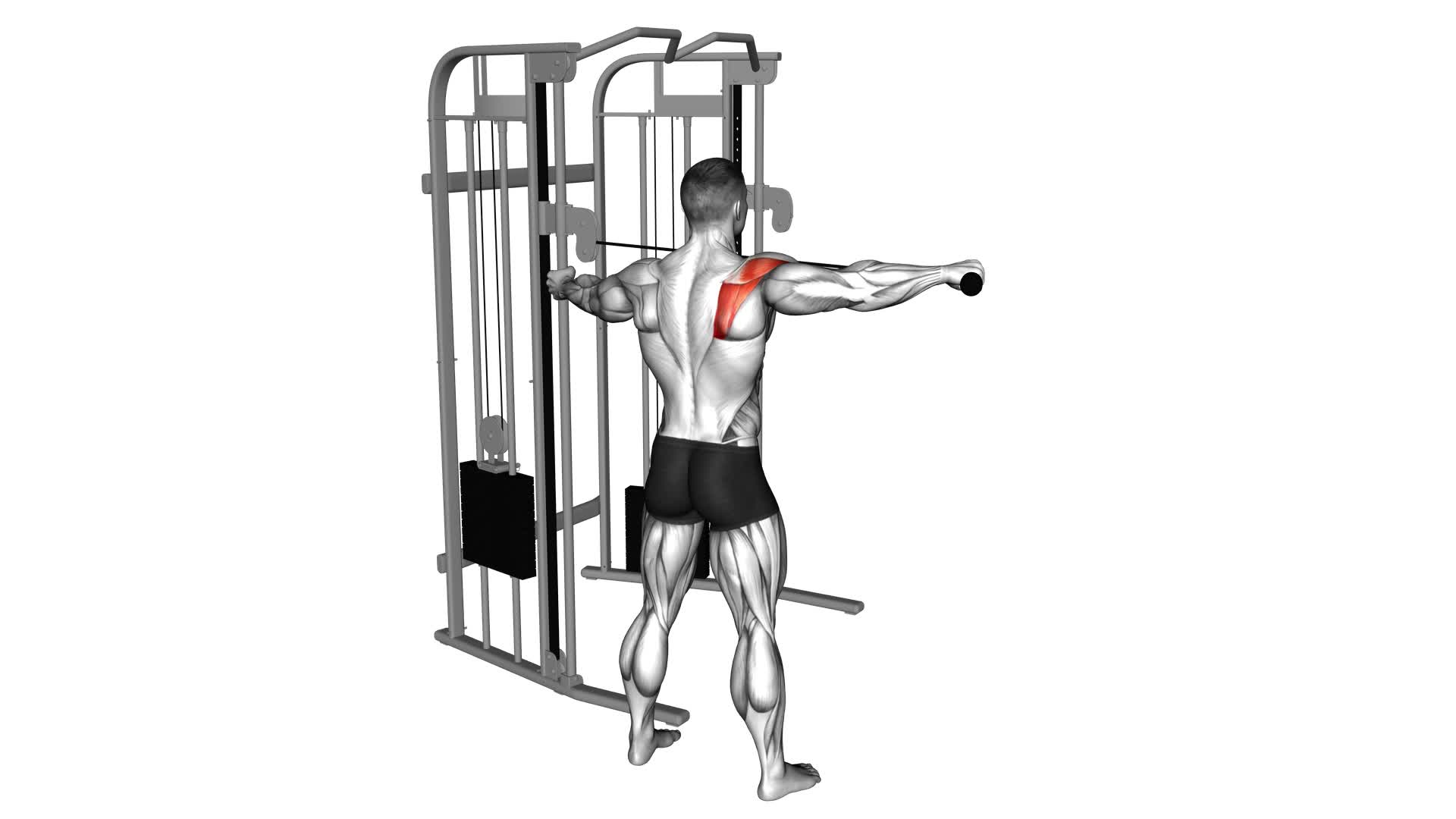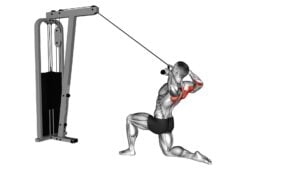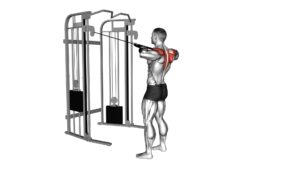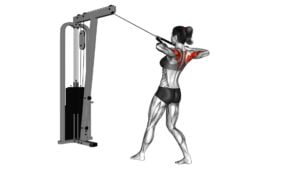Cable Standing Single Delt Row (male) – Video Exercise Guide & Tips

Looking to strengthen your deltoids? Check out this video exercise guide and tips for the cable standing single delt row.
Watch This Exercise Video
This exercise targets your shoulder muscles and can be done using a cable machine.
Learn the proper technique, common mistakes to avoid, and tips for maximizing your results.
Get ready to take your deltoid workout to the next level with this effective exercise.
Key Takeaways
- Cable Standing Single Delt Row targets and strengthens deltoid muscles in the shoulders.
- The exercise activates the anterior, lateral, and posterior deltoids, improving shoulder stability and upper body strength.
- The exercise offers versatility with variations and modifications, allowing for a variety in the workout routine.
- Proper form and technique, gradually increasing intensity, and consuming enough protein are key factors for maximizing results.
Benefits of Cable Standing Single Delt Row
The main benefit of the Cable Standing Single Delt Row is that it targets and strengthens the deltoid muscles in your shoulders. This exercise is known for its ability to activate the muscles in the shoulder region, specifically the anterior, lateral, and posterior deltoids. By performing the Cable Standing Single Delt Row, you can effectively isolate and engage these muscles, leading to improved shoulder stability and overall upper body strength.
One of the advantages of this exercise is its versatility. There are several variations and modifications that can be incorporated to suit your fitness level and goals. For instance, you can adjust the weight resistance, change the grip position, or even perform the exercise unilaterally or bilaterally. These variations allow you to target different parts of the deltoid muscles and add variety to your workout routine.
Incorporating the Cable Standing Single Delt Row into your exercise regimen can help you develop stronger and more defined shoulders. It's important to note that proper form and technique are crucial to maximize the benefits and prevent injury.
Now, let's move on to discussing the equipment and set-up for this exercise.
Equipment and Set-Up for the Exercise
To properly set up for the Cable Standing Single Delt Row exercise, frequently position the cable machine at a height that allows for a comfortable range of motion. This will ensure that you can perform the exercise correctly and effectively.
Here are three important points to consider when setting up the equipment for this exercise:
- Adjust the cable machine: Start by setting the cable machine at a height that aligns with your shoulder level. This will allow you to maintain proper form throughout the movement and avoid unnecessary strain on your shoulders.
- Attach the handle: Attach a single handle to the cable machine. Make sure it's securely fastened to the cable, ensuring that it won't come loose during your workout.
- Stand in the correct position: Stand facing the cable machine, with your feet shoulder-width apart and your knees slightly bent. Grab the handle with your palm facing down and your arm fully extended in front of you. This will be your starting position for the exercise.
Step-by-Step Guide on How to Perform the Exercise
To perform the Cable Standing Single Delt Row exercise, follow these step-by-step instructions.
- Start by attaching a single handle to the low pulley cable machine.
- Stand facing the machine with your feet shoulder-width apart and knees slightly bent.
- Grasp the handle with an overhand grip, palm facing inwards.
- Keep your back straight and core engaged throughout the exercise.
Begin the movement by pulling the handle towards your body, keeping your elbow close to your side.
- Focus on squeezing your shoulder blades together as you pull.
- Pause for a moment at the top of the movement, ensuring a full contraction of your deltoid muscles.
Slowly lower the handle back to the starting position, fully extending your arm while maintaining control.
- Repeat for the desired number of repetitions.
It is important to maintain proper form for the Cable Standing Single Delt Row exercise.
- Avoid using momentum or swinging your body to complete the movement.
- Instead, focus on controlled and deliberate motions to engage the targeted muscles effectively.
Variations of the Cable Standing Single Delt Row can be done by using different grips or handles.
- Experiment with a neutral grip or try using a rope attachment for added variety.
Remember to always consult with a qualified fitness professional before attempting any new exercise to ensure proper form and technique.
Common Mistakes to Avoid
To avoid common mistakes in the Cable Standing Single Delt Row exercise, be sure to maintain proper form and avoid using momentum or swinging your body. Here are three common mistakes to avoid:
- Improper Form: It's essential to maintain proper form throughout the exercise to maximize muscle activation and prevent injury. Keep your back straight, shoulders relaxed, and core engaged. Avoid rounding your shoulders or arching your back.
- Using Momentum: Using momentum or swinging your body can take away the focus from your deltoids and reduce the effectiveness of the exercise. Instead, focus on controlled movements, pulling the cable towards your body using your shoulder muscles.
- Neglecting Muscle Activation: To ensure proper muscle activation, make sure to squeeze your shoulder blades together at the peak of the movement. This will engage your deltoids and promote better results.
By avoiding these common mistakes, you can perform the Cable Standing Single Delt Row exercise with proper form and maximize muscle activation.
Remember to always listen to your body, start with lighter weights, and gradually increase the intensity as you become more comfortable with the exercise.
Tips for Maximizing Your Results
Now, let's delve into some tips that will help you maximize your results in the Cable Standing Single Delt Row exercise.
To ensure effective training techniques and achieve optimal muscle growth, it's important to focus on both your workout routine and your nutrition.
Firstly, when performing the Cable Standing Single Delt Row, make sure to maintain proper form and technique. Keep your back straight, shoulders down and back, and engage your core throughout the movement. This will help you target the muscles in your shoulders and upper back more effectively.
In addition to proper form, it's crucial to progressively increase the intensity and resistance of your workouts. This can be achieved by gradually increasing the weight or the number of repetitions and sets. By challenging your muscles, you stimulate growth and strength development.
Nutrition also plays a vital role in maximizing your results. It's important to consume enough protein to support muscle growth and repair. Include lean sources of protein, such as chicken, fish, tofu, or beans, in your meals. Additionally, ensure you're getting enough carbohydrates for energy and healthy fats for overall health.
Frequently Asked Questions
How Many Sets and Repetitions Should I Do for the Cable Standing Single Delt Row Exercise?
To determine the number of sets and repetitions for the cable standing single delt row exercise, consider your workout intensity and proper form.
It's essential to challenge yourself without sacrificing technique. Start with a weight that allows you to complete 8-12 reps with proper form. Aim for 3-4 sets, resting 1-2 minutes between each set.
Gradually increase the weight as you get stronger, maintaining the desired rep range for optimal muscle development.
Can I Perform the Cable Standing Single Delt Row Exercise Using Dumbbells Instead of a Cable Machine?
Yes, you can substitute dumbbells for the cable machine when performing the cable standing single delt row exercise.
This variation allows you to target the same muscles while providing a different challenge to your workout.
By using dumbbells, you can modify the exercise to suit your preferences and adjust the resistance according to your fitness level.
Remember to maintain proper form and control throughout the movement to maximize the benefits.
Is the Cable Standing Single Delt Row Exercise Suitable for Beginners?
The cable standing single delt row exercise can be suitable for beginners with proper form and technique.
To perform it correctly, stand with your feet shoulder-width apart, grasp the cable handle with one hand, and pull it towards your torso while keeping your back straight.
For beginners, it's important to start with a lighter weight and gradually increase the resistance as you build strength.
This exercise can help improve posture and strengthen the deltoid muscles.
How Often Should I Incorporate the Cable Standing Single Delt Row Exercise Into My Workout Routine?
To determine the incorporation frequency of the cable standing single delt row exercise into your workout routine, it's important to focus on proper form and technique. This will help prevent injury and maximize results.
It's recommended to include this exercise 2-3 times a week, allowing for rest days in between. However, it's always advised to listen to your body and adjust accordingly based on your fitness level and recovery ability.
Can the Cable Standing Single Delt Row Exercise Help in Improving Posture and Reducing Shoulder Pain?
To improve your posture and reduce shoulder pain, incorporating the cable standing single delt row exercise into your routine can be beneficial.
This exercise targets the deltoid muscles in your shoulders, which play a key role in maintaining proper posture.
By strengthening these muscles, you can improve your overall posture and alleviate shoulder pain.
Additionally, the cable standing single delt row exercise helps to develop upper back strength, contributing to better posture and reduced discomfort.
Conclusion
In conclusion, the cable standing single delt row is an effective exercise for targeting the deltoid muscles.
By using a cable machine, you can adjust the resistance to suit your fitness level.
Following the correct form and avoiding common mistakes will ensure you get the most out of this exercise.
Incorporate this exercise into your routine and you'll be on your way to stronger and more defined deltoids.

Author
Years ago, the spark of my life’s passion ignited in my mind the moment I stepped into the local gym for the first time. The inaugural bead of perspiration, the initial endeavor, the very first surge of endorphins, and a sense of pride that washed over me post-workout marked the beginning of my deep-seated interest in strength sports, fitness, and sports nutrition. This very curiosity blossomed rapidly into a profound fascination, propelling me to earn a Master’s degree in Physical Education from the Academy of Physical Education in Krakow, followed by a Sports Manager diploma from the Jagiellonian University. My journey of growth led me to gain more specialized qualifications, such as being a certified personal trainer with a focus on sports dietetics, a lifeguard, and an instructor for wellness and corrective gymnastics. Theoretical knowledge paired seamlessly with practical experience, reinforcing my belief that the transformation of individuals under my guidance was also a reflection of my personal growth. This belief holds true even today. Each day, I strive to push the boundaries and explore new realms. These realms gently elevate me to greater heights. The unique combination of passion for my field and the continuous quest for growth fuels my drive to break new ground.







